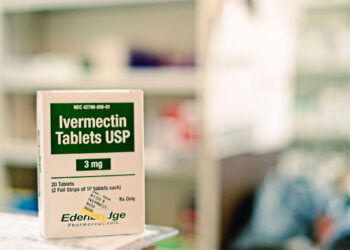SAN DIEGO — The majority of colorectal cancers (CRCs) that emerge following a negative colonoscopy and polypectomy occur prior to recommended surveillance exams, and those cases are more likely to be at an advanced stage, according to new research.
Of key factors linked to a higher risk for such cases, one stands out — the quality of the baseline colonoscopy procedure.
“A lot of the neoplasia that we see after polypectomy was probably either missed or incompletely resected at baseline,” said Samir Gupta, MD, a professor of medicine in the Division of Gastroenterology, UC San Diego Health, La Jolla, California, in discussing the topic at Digestive Diseases Week (DDW) 2025.
“Therefore, what is key to emphasize is that [colonoscopy] quality is probably the most important factor in post-polypectomy risk,” he said.
“But, advantageously, it’s also the most modifiable factor.”
Research shows that the risk for CRC incidence following a colonoscopy ranges from just about 3.4 to 5 cases per 10,000 person-years when baseline findings show no adenoma or a low risk; however, higher rates ranging from 13.8 to 20.9 cases per 10,000 person-years are observed for high-risk adenomas or serrated polyps, Gupta reported.
“Compared with those who have normal colonoscopy, the risk [for CRC] with high-risk adenomas is increased by nearly threefold,” Gupta said.
In a recent study of US veterans who underwent a colonoscopy with polypectomy between 1999 and 2016 that was labeled negative for cancer, Gupta and his colleagues found that over a median follow-up of 3.9 years, as many as 55% of 396 CRCs that occurred post-polypectomy were detected prior to the recommended surveillance colonoscopy.
The study also showed that 40% of post-polypectomy CRC deaths occurred prior to the recommended surveillance exam over a median follow-up of 4.2 years.
Cancers detected prior to the recommended surveillance exam were more likely to be diagnosed as stage IV compared with those diagnosed later (16% prior to recommended surveillance vs 2.1% and 8.3% during and after, respectively; P = .003).
Importantly, the most prominent reason for the cancers emerging in the interval before follow-up surveillance was missed lesions during the baseline colonoscopy (60%), Gupta said.
Colonoscopist Skill and Benchmarks
A larger study of 173,288 colonoscopies further underscores colonoscopist skill as a key factor in post-polypectomy CRC, showing that colonoscopists with low vs high performance quality — defined as an adenoma detection rate (ADR) of either < 20% vs ≥ 20% — had higher 10-year cumulative rates of CRC incidence among patients following a negative colonoscopy (P < .001).
Likewise, in another analysis of low-risk vs high-risk polyps, a higher colonoscopist performance status was significantly associated with lower rates of CRCs (P < .001).
“Higher colonoscopist performance was associated with a lower cumulative colorectal cancer risk within each [polyp risk] group, such that the cumulative risk after high-risk adenoma removal by a higher performing colonoscopist is similar to that in patients who had a low-risk adenoma removed by a lower performer,” Gupta explained.
“So, this has nothing to do with the type of polyp that was removed — it really has to do with the quality of the colonoscopist,” he said.
The American College of Gastroenterology and the American Society for Gastrointestinal Endoscopy Quality Task Force recently updated recommended benchmarks for colonoscopists for detecting polyps, said Aasma Shaukat, MD, director of GI Outcomes Research at NYU Grossman School of Medicine, New York City, in further discussing the issue in the session.
They recommend an ADR of 35% overall, with the recommended benchmark being ≥ 40% for men aged 45 years or older and ≥ 30% for women aged 45 years or older, with a rate of 50% for patients aged 45 years or older with an abnormal stool test, Shaukat explained.
And “these are minimum benchmarks,” she said. “Multiple studies suggest that, in fact, the reported rates are much higher.”
Among key strategies for detecting elusive adenomas is the need to slow down withdrawal time during the colonoscopy in order to take as close a look as possible, Shaukat emphasized.
She noted research that her team has published showing that physicians’ shorter withdrawal times were in fact inversely associated with an increased risk for cancers occurring prior to the recommended surveillance (P < .0001).
“Multiple studies have shown it isn’t just the time but the technique with withdrawal,” she added, underscoring the need to flatten as much of the mucosa and folds as possible during the withdrawal. “It’s important to perfect our technique.”
Sessile serrated lesions, with often subtle and indistinct borders, can be among the most difficult polyps to remove, Shaukat noted. Studies have shown that as many as 31% of sessile serrated lesions are incompletely resected, compared with about 7% of tubular adenomas.
Patient Compliance Can’t Be Counted On
In addition to physician-related factors, patients themselves can also play a role in post-polypectomy cancer risk — specifically in not complying with surveillance recommendations, with reasons ranging from cost to the invasiveness and burden of undergoing a surveillance colonoscopy.
“Colonoscopies are expensive, and participation is suboptimal,” Gupta said.
One study of high-risk patients with adenoma shows that only 64% received surveillance, and many who did receive surveillance received it late, he noted.
This underscores the need for better prevention as well as follow-up strategies, he added.
Recommendations for surveillance exams from the World Endoscopy Organization range from every 3 to 10 years for patients with polyps, depending on the number, size, and type of polyps, to every 10 years for those with normal colonoscopies and no polyps.
A key potential solution to improve patient monitoring within those periods is the use of fecal immunochemical tests (FITs), which are noninvasive, substantially less burdensome alternatives to colonoscopies, which check for blood in the stool, Gupta said.
While the tests can’t replace the gold standard of colonoscopies, the tests nevertheless can play an important role in monitoring patients, he said.
Evidence supporting their benefits includes a recent important study of 2226 patients who underwent either post-polypectomy colonoscopy, FIT (either with FOB Gold or OC-Sensor), or FIT-fecal DNA (Cologuard) test, he noted.
The results showed that the OC-Sensor FIT had a 71% sensitivity, and FIT-fecal DNA had a sensitivity of 86% in the detection of CRC.
Importantly, the study found that a positive FIT result prior to the recommended surveillance colonoscopy reduced the time-to-diagnosis for CRC and advanced adenoma by a median of 30 and 20 months, respectively.
FIT Tests Potentially a ‘Major Advantage’
“The predictive models and these noninvasive tests are likely better than current guidelines for predicting who has metachronous advanced neoplasia or colon cancer,” Gupta said.
“For this reason, I really think that these alternatives have a potentially major advantage in reducing colonoscopy burdens. These alternatives are worthwhile of studying, and we really do need to consider them,” he said.
More broadly, the collective evidence points to factors that can and should be addressed with a proactive diligence, Gupta noted.
“We need to be able to shift from using guidelines that are just based on the number, size, and histology of polyps to a scenario where we’re doing very high-quality colonoscopies with excellent ADR rates and complete polyp excision,” Gupta said.
Furthermore, “the use of tools for more precise risk stratification could result in a big, low-risk group that could just require 10-year colonoscopy surveillance or maybe even periodic noninvasive surveillance, and a much smaller high-risk group that we could really focus our attention on, doing surveillance colonoscopy every 3-5 years or maybe even intense noninvasive surveillance.”
Gupta’s disclosures included relationships with Guardant Health, Universal DX, CellMax, and Geneoscopy. Shaukat’s disclosures included relationships with Iterative Health and Freenome.
Source link : https://www.medscape.com/viewarticle/post-polypectomy-colorectal-cancers-common-before-follow-2025a1000boh?src=rss
Author :
Publish date : 2025-05-14 08:09:00
Copyright for syndicated content belongs to the linked Source.














